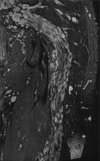High-resolution MR neurography of diffuse peripheral nerve lesions
- PMID: 20966057
- PMCID: PMC7964353
- DOI: 10.3174/ajnr.A2257
High-resolution MR neurography of diffuse peripheral nerve lesions
Abstract
High-resolution MR imaging of peripheral nerves is becoming more common and practical with the increasing availability of 3T magnets. There are multiple reports of MR imaging of peripheral nerves in compression and entrapment neuropathies. However, there is a relative paucity of literature on MRN appearance of diffuse peripheral nerve lesions. We attempted to highlight the salient imaging features of myriad diffuse peripheral nerve disorders and imaging techniques for MRN. Using clinical and pathologically proved relevant examples, we present the MRN appearance of various types of diffuse peripheral nerve lesions, such as traumatic, inflammatory, infectious, hereditary, radiation-induced, neoplastic, and tumor variants.
Figures
















References
-
- Kim S, Choi JY, Huh YM, et al. . Role of magnetic resonance imaging in entrapment and compressive neuropathy: what, where, and how to see the peripheral nerves on the musculoskeletal magnetic resonance image. Part 1. Overview and lower extremity. Eur Radiol 2007;17:139–49 - PubMed
-
- Kim S, Choi JY, Huh YM, et al. . Role of magnetic resonance imaging in entrapment and compressive neuropathy: what, where, and how to see the peripheral nerves on the musculoskeletal magnetic resonance image. Part 2. Upper extremity. Eur Radiol 2007;17:509–22 - PubMed
-
- Amrami KK, Felmlee JP, Spinner RJ.. MRI of peripheral nerves. Neurosurg Clin N Am 2008;19:559–72 vi - PubMed
-
- Kuntz C, 4th, Blake L, Britz G, et al. . Magnetic resonance neurography of peripheral nerve lesions in the lower extremity. Neurosurgery 1996;39:750–56 discussion 756–57 - PubMed
Publication types
MeSH terms
LinkOut - more resources
Full Text Sources
Medical
